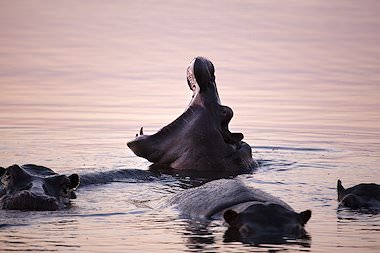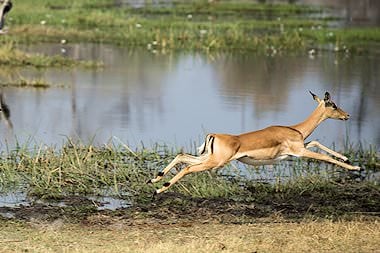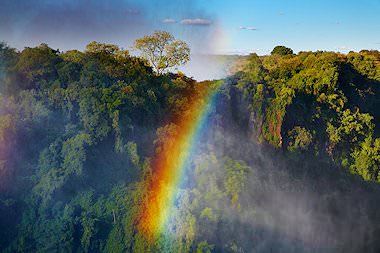Botswana’s Moremi Game Reserve
Help Me Plan- Home
- >
- African Travel
- >
- Botswana
- >
- Moremi Game Reserve
Moremi Game Reserve Destination Guide
The reserve protects a pristine slice of Botswana's famous Okavango Delta, one of the top safari destinations in Africa. The eastern section was proclaimed a nature reserve in 1963 by the Batawana tribe, led by Chief Moremi III's widow. Today it offers year-round game viewing, mokoro safaris, and luxury camps in a vast, water-rich wilderness.
Getting to Moremi Game Reserve
By Air: Guests arrive by light charter flight to a local airstrip. From there, expert guides transfer them in open 4x4 vehicles to their lodge. Much of Moremi is waterlogged, requiring considerable skill and local knowledge to navigate.
By Road: Access is primarily via light charter flight to a local airstrip; self-drive is not recommended due to waterlogged terrain and complex navigation.
Weather & Best Time to Visit
Accessible year-round.
Nov–Mar brings afternoon rains, lush scenery, and peak birding; some tracks become waterlogged.
Apr–Oct is dry with the best general game viewing. The Delta’s water levels typically peak mid-year, fed by Angolan rains.

Chief's Island is perhaps the Okavango's most famous island. Once the hunting ground of Chief Moremi, a traditional leader and visionary conservationist, it now plays a central role in conservation. Bird life is prolific, with numerous waterbird and forest species, including goose, duck, and a variety of heron.
Safari Packages that visit Moremi
Luxury and top-end trips to the Okavango Delta, Victoria Falls, Linyanti, Chobe National Park, and Livingstone.
Some of Botswana's best safari camps and experiences make this fly-in package unforgettable.
This safari, which lasts just over a week, visits two areas of Chobe National Park and the Okavango Delta.
Visits to the two most popular safari destinations in Botswana precede two nights at the awe-inspiring Victoria Falls.
Recommended Safari Camps
Moremi Game Reserve is home to some of Africa's most remote and exceptional safari camps.
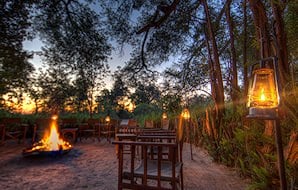
Camp Moremi
Camp Moremi offers classic African safaris from a camp with only twelve tented guest rooms.
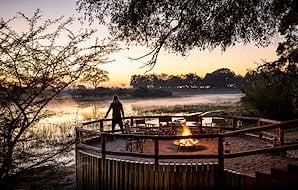
Chiefs Camp
This small luxury safari camp on Chief's Island in the heart of the Okavango Delta offers land- and water-based game viewing.
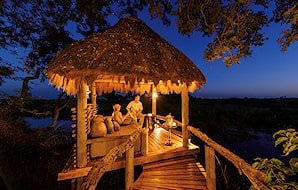
Mombo Camp
Mombo is one of Botswana's most revered safari destinations, with a prime setting on the northern tip of Chief's Island.
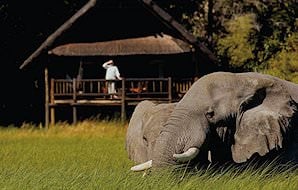
Khwai River Lodge
Khwai River Lodge overlooks a floodplain in a private concession just north of the Moremi Game Reserve.
Reasons to visit Moremi Game Reserve
Natural Water World
The annual rains transform Moremi into a world of islands and waterways. An abundance of animals gathers in the nurturing wetlands of the Okavango. Guests can enjoy water-based game viewing on different vessels, including powerboats and the traditional mokoro.
Sitatunga
The sitatunga, also called the marshbuck, is a swamp antelope. It is sometimes described as an amphibious antelope and is notable for physical characteristics adapted to a water-based habitat.
Xakanaxa Lagoon
In the heart of the Moremi Game Reserve, where the desert meets the delta, lies the Xakanaxa Lagoon. Varied vegetation creates habitats that host abundant fauna and flora. It is excellent for birding and wildlife sightings, including elephant, buffalo, giraffe, hippo, kudu, lechwe, and, with luck, leopard.
Experiences to Savor in Moremi
Game-viewing experiences are unique to the area, focusing on the bounties of the delta's waterways. Mokoro trips are inherently characteristic of safaris in this area.
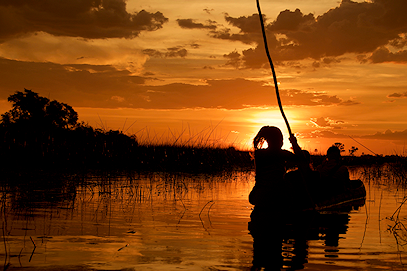
Appreciating the Natural World
There is no better way to experience the wonders of the Okavango Delta than in the same manner locals do—by mokoro canoe. Similar to traditional dugouts, they offer a serene, low-impact way to explore.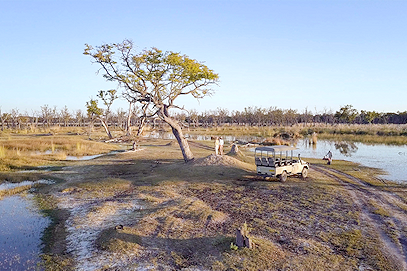
A Whole New World
Upon arrival at Moremi, you’ll feel transported to a different dimension. The wetlands are indelibly unique, as are the wildlife and the people that call it home.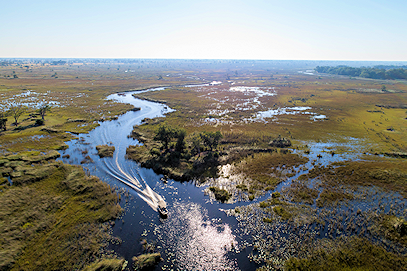
Just Look Down
As your light charter flight approaches the reserve, take a moment to glimpse the region from your eagle's-eye vantage point. The rivers vein into the plains, snaking between trees and shrubs, with wildlife visible below.Useful Information
History
The Moremi Game Reserve was officially proclaimed on 15 March 1963 and named after Chief Moremi III of the Batswana people. The reserve is considered one of the first in Africa formed by indigenous residents. It was not Chief Moremi III who started it, but his widow, who was concerned about degradation due to unsustainable hunting and cattle encroachment. Initially, the reserve only included what is known as “the Mopane Tongue,” but in the 1970s it was expanded to include Chief Moremi's royal hunting grounds. Only a game reserve was proclaimed—not a national park—which allowed residents to continue living in the area.
Ngamiland, the area around Moremi, was initially occupied by the Basarwa or Bushmen. In the 18th century, the WaYeyi, a Bantu-speaking people, moved there from north-western Botswana and north-eastern Namibia. The Basarwa were led there by a local fisherman and hunter named Hankuzi, who married a WaYeyi woman, fostering a peaceful bond between the Bushmen and the WaYeyi. The Basarwa taught new fishing techniques, and the WaYeyi brought canoe-building know-how to Ngamiland. When the influential Batswana arrived in the 19th century, the WaYeyi voluntarily became serfs of the Batswana, attaching to powerful households.
Wildlife
The waters of the Okavango Delta draw masses of wildlife, making Moremi both a seasonal and permanent home to diverse species. Huge elephant and buffalo herds dominate the landscape, with the endangered black and white rhinoceros found only on Chief's Island. The reserve is one of the few places hosting both brown and spotted hyena. Plains game species like giraffe, Burchell's zebra, and blue wildebeest are abundant, alongside beautiful antelope such as sitatunga, lechwe, greater kudu, and sable antelope. Healthy populations of endangered African wild dog reside here, while cheetah also inhabit the area, though they are elusive, often avoiding larger predators like lion and leopard.
Birdlife is prolific, with over 400 species recorded, including Pel's fishing owl and the lilac-breasted roller. The black-backed jackal is a frequent scavenger, its call echoing at night. During the wet season (Nov–Mar), newborns and migrant birds add vibrancy, while the dry season (Apr–Oct) concentrates animals around permanent water sources, enhancing game viewing. This rich biodiversity, set within a pristine wetland ecosystem, makes Moremi one of Africa’s premier wildlife destinations.
Vegetation & Terrain
This conservation area has received many accolades for its protection efforts. In addition to being the first African reserve established by residents concerned for their ancestral heritage, it is also the only officially protected area in the Okavango Delta. The reserve covers almost a third of the hallowed Okavango and boasts one of the continent's richest and most diverse ecosystems. Seasonally or perennially wet, it encompasses waterways, pools, lagoons, pans, riverine vegetation, acacia and mopane forests, and grasslands.
The mopane forests are a major vegetation attraction. The trees can grow to impressive size and dwarf the understory. Moremi is known for its rivers—the Khwai and Jao and their tributaries—which vein into the plains and sustain many life forms. Negotiations are underway to include the park in the Kavango-Zambezi Transfrontier Conservation Area, which will ultimately span five countries.
Activities
Moremi has been described as one of the most beautiful reserves in the world and has won numerous travel and tourism awards. The diverse landscape and ecology offer so much to see that the daily expeditions into various areas are highly sought after. The waterways outside the reserve are best explored by boat, and various water-based activities are available, including traditional mokoro outings (canoe-like, hollowed-out tree trunks). Some areas are squarely in the wetlands and only offer water-based activities. Game drives are available in the drier regions and may include night drives and guided walks (contingent on water levels).
Landscape and wildlife photographers and cinematographers will find endless picture-perfect moments. Watch for the Big Five, endangered African wild dogs, and countless birds that thrive in these wetlands. Swimming in rivers and tributaries is not allowed; this is the domain of crocodiles and hippos. Some camps have swimming pools where visitors can cool off. Fishing is also offered at select camps.

